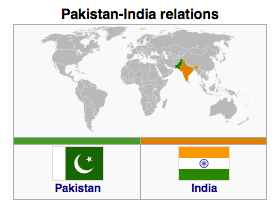India-Pakistan Nuclear CBMs: Where Talks Fear To Tread – Analysis
By IPCS
By Tanvi Kulkarni
The ‘Expert level Meeting on Conventional and Nuclear CBMs’ that took place in Islamabad on 26-27 December 2011 constitute the fifth round of Indo-Pak talks on conventional CBMs and the sixth round on nuclear CBMs (NCBMs). These talks indicated that the complications which engulf the task of confidence building between the two adversarial nuclear weapons countries emanate not just from their historical and existential animosity; but the approach to NCBMs is marred by a fear of transcendence. To gauge how the strategic community in India looks at this issue, the author of this commentary posed questions to a few strategic experts to assess the following questions: what does it mean to move beyond self-imposed limits? What do Indo-Pak NCBMs need to constitute?
The Lahore Canopy: Staying Put

The Lahore Memorandum of Understanding (MoU) of 1999 provides the broad framework for NCBMs between India and Pakistan. To its credit, markedly, are the hotlines established between the DGMOs and between the Foreign Secretaries, the Agreement on Pre-notification of Flight Testing of Ballistic Missiles and the Agreement on Reducing the Risks from Accidents Relating to Nuclear Weapons. Apart from these, India and Pakistan have been annually exchanging lists of their nuclear-related facilities that fall under the Agreement of 1988 on the Prohibition of Attack against Nuclear Installations and Facilities (a list was exchanged for the 21st time on 1 January 2012). These are considered as good models of communication CBMs. At the December 2011 Expert Level meeting, and at previous occasions, the issues that remained at stalemate include adding cruise missiles under the pre-notification agreement, Pakistan declaring its nuclear doctrine and defining its command and control setup, mutual adoption of the Nuclear No First Use (NFU) policy and the establishment of a Nuclear Strategic Restraint Regime (NSRR).
Communication to Constraint: Moving Ahead
Ideally, the task is to advance from communication to transparency and constraint, or perhaps in other words from being declaratory to action-oriented. According to Vice Admiral Vijay Shankar, Former Commander-in-Chief, Strategic Forces Command of India, “the Lahore MoU identifies the need to establish CBMs. It is subjective in form and it posits a fleshing out.” This would comprise using its principles to undertake functional and institutional measures; discussing a joint risk reduction centre could serve as an example of this. So far, Indo-Pak dialogues on NCBMs have emphasized only on means of communication (exchange of data, notification of developments and hotlines). The constant reference to the Lahore MoU to justify and review these CBMs has rendered the document itself to appear restrictive and not as a guideline to explore new initiatives.
Much to the disappointment of the spirit of the Lahore Declaration, meager progress has been made towards understanding each others’ national interests, security concepts and nuclear doctrines. The creation of an ambience for these measures will require making the interests ‘transparent and insulated from the overall hostility between the two countries’, according to Vice Admiral Shankar. The interdependence between conventional CBMs and nuclear CBMs makes their strict categorization difficult. Pakistan’s outright rejection to officially declare its nuclear doctrine warrants more than constant persuasion. Experts have suggested measures like clarifying terminologies and arriving at a mutually acceptable lexicon. This would call for, in the words of Vice Admiral Shankar, ‘going beyond party lines’; and perhaps the unwillingness to do so results in this task being usually left to be undertaken at the level of non-official interaction.
Bilateral cooperation in certain civilian nuclear sectors is prospect-worthy. According to Mr LV Krishnan, Former Director, Safety Research and Health Physics at the Indira Gandhi Centre for Atomic Research (IGCAR), Kalpakkam, ‘cooperation in nuclear medicine should be free of controversy and India could cooperate in this field’. Similarly, Pakistan’s proposal for joint development of nuclear technology applications in agriculture merits discussion by experts. As for nuclear power generation, the unknown extent of Chinese involvement in Pakistan’s nuclear power industry generates skepticism for India. Besides, India has advanced in designing and building reactors and both sides should convince themselves of gains from such cooperation, indicates Dr Krishnan. Civil nuclear cooperation could become a good confidence building ‘mechanism’.
The Leap of Faith
The sixth round of Indo-Pak dialogue on NCBMs that prompted this commentary demonstrates a deficiency in approach. Old arguments have been met with older and unrelenting objections and rejections. The refusal to experiment beyond existing frameworks and mechanisms can choke confidence building efforts. The leap of faith does not mean that mutual distrust can be turned around overnight; it calls for transcending beyond traditionally-certified measures. Else, future confidence building dialogues will become, to put it in the words of Vice Admiral Shankar, “a perfunctory ritual than an instrument to bring about stability and understanding.”
Tanvi Kulkarni
Research Officer, NSP, IPCS
email: [email protected]
